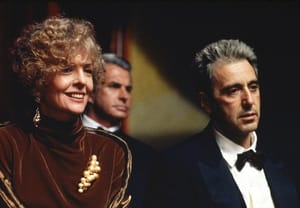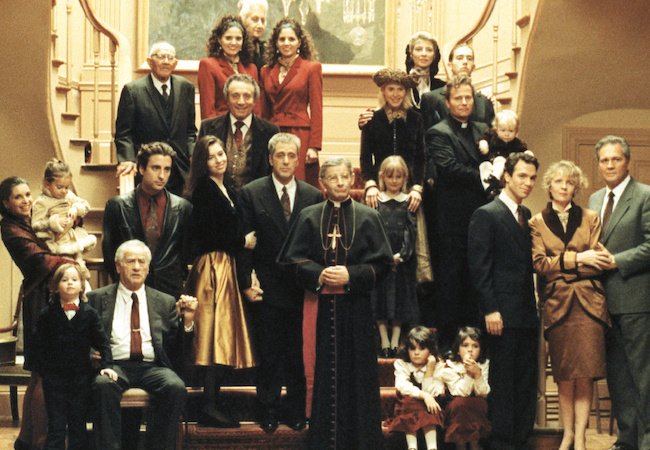
Francis Ford Coppola is marking the 30th anniversary of The Godfather Part III by re-editing and re-releasing it as The Godfather Coda: The Death of Michael Corleone. He didn’t need to.
The flaws of The Godfather Part III can’t be fixed with editing, and the attempts to smooth it out make the film harder to criticize — but also harder to love.
Spend a few minutes Googling “Godfather III” and you’ll find the usual internet know-it-alls complaining that it isn’t nearly as good as The Godfather or The Godfather Part II. That critique could also be leveled at almost every film every made.
Google a little more and you’ll see more specific criticisms that Coppola shouldn’t have cast his then-teenage daughter, Sofia Coppola, in the crucial role of Mary Corleone, daughter of Al Pacino’s Michael Corleone. And you’ll find complaints that the film’s Vatican storyline is needlessly confusing.
To these I would add another criticism. The first two Godfather films were filled with magnificent, quotable, wise dialogue, courtesy of Coppola and Mario Puzo. But The Godfather Part III, and in turn Godfather Coda, have at most two memorable lines: “Just when I thought I was out, they pull me back in,” and, “The only wealth in this world is children.”
Coppola’s new edit of the film will get us all talking about the greatness of The Godfather saga right before the holidays, so dads and kids wondering what to get them should rejoice. The third Godfather still has plenty to enjoy: A magnificent helicopter attack, great music and locales, solid work by key players Pacino, Diane Keaton, Andy Garcia and Talia Shire, and surprise appearances by everyone from Bridget Fonda to Catherine Scorsese to former San Francisco mayor (and Kamala Harris ex) Willie Brown.
But to fix the flaws of Godfather Part III would require rewriting and reshoots, not cutting or moving around scenes.
Also Read: Two Strangers Tried to Make a Movie Together. What Could Possibly Go Wrong?
Coppola tries to address the Vatican plotline by leaning into it, perhaps in the hope that giving it more prominence will make it easier to follow. But the Vatican bit still feels out of place for those of us who think of the Godfather films as a saga about family, not corporate intrigue or plots to kill popes.
In Godfather Coda, the Vatican stuff at times threatens to overwhelm the family story — and perhaps that’s just what Francis Ford Coppola wants. Because, after all, the only wealth in this world is children.
It seems reasonable that the director would be good and tired of the decades of criticism his daughter has received for her role in his film. Neither of them have anything to apologize for: He’s one of the greatest filmmakers of his generation, and she’s one of the greatest of hers. I’m exhausted of hacks continuing to pile on about the acting a teenager did 30 years ago.

Francis Ford Coppola has re-edited The Godfather Part III as Godfather Coda: The Death of Michael Corleone.
But yes: The film does suffer, in places, from her monotone, California-cool line readings, and she contributes, by virtue of not being a huge movie star, to the film’s overall lack of star power in several places where it might have infused the film with some additional energy and urgency. The original two Godfather films boasted a murderers’ row of great actors. Godfather Part III substitutes the excellent Robert Duvall with the acceptable George Hamilton, fills several potentially great roles with competent but unmemorable character actors, and gives Sofia Coppola a role that was originally to have been played by Winona Ryder near the height of her wounded goth phase. She would have brought with her all the tragedy and empathy of her past roles, and might have made us root for Mary a little more.
The new edit, especially early on, seems to intentionally shift the focus away from Mary and her impossible affair with her cousin Vincent (Garcia), and toward the Vatican plot line that feels too big and unwieldy to take seriously. Whatever the criticisms, we cared about Mary in the original cut of Godfather Part III. She, like Sofia Coppola, was being pulled into something huge, and we wanted her to succeed. (“It is obvious that this teenage girl is not a trained actress,” wrote Pauline Kael. “But . . . she gives the film a breath of life . . . I grew to like her.”)
Coppola seems more protective of his daughter’s performance in the new version — he noticeably trims some stilted line readings in a balcony scene where she expresses apprehension about her role in a Corleone family foundation. The new edit off the film makes Mary seem cooler, less vulnerable. But she needs to be the emotional heart of the whole thing, and she’s less centered now.
Coppola promised when he announced Godfather Coda that it would have a new beginning and ending, and it kind of does: The scene that now starts the film takes place about a quarter of the way through the original Godfather Part III.
And the new ending… is shocking, honestly. Maybe the original was unnecessarily harsh, but it was so well-acted that it carried some wincing emotion, and the change feels like a punch pulled.
Now 81, and perhaps thinking about his legacy, Francis Ford Coppola in recent years of re-edited his past films Apocalypse Now and The Cotton Club. I’m glad for any excuse to talk about his movies, but nothing about his body of work needs revising.
It is often soaring, frequently astonishing, usually beautiful, and sometimes flawed by excessive sentiment and love for family. A filmmaker could do a lot worse. Few, if any, have done better.
The Godfather Coda: The Death of Michael Corleone will be released in select theaters Friday and on Blu-Ray and digital on Dec. 8.
Share:

